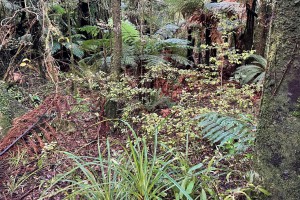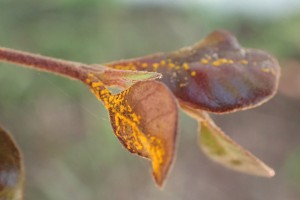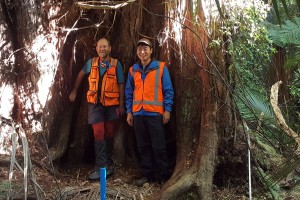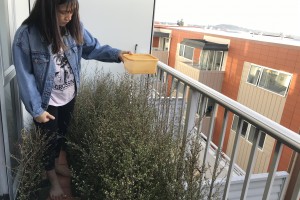Ecosystem impacts
Once Austropuccinia psidii establishes at a site, it will likely have impacts beyond host plant disease and death. For example, other microorganisms (e.g., bacteria and fungi) are likely to be impacted. Non-host plants may increase in abundance. Changes in plant and microbial community members could lead to changes in ecosystem functions, such as water fluxes into and out of the ecosystem, carbon storage in soils, and nutrient movements.
We aim to develop a holistic understanding of the pathogen, hosts, and potential ecosystem changes, to enable development of the best possible management approaches. This area is split into multiple work streams:
Mānuka forest impacts
compares ecosystem characteristics and functions in planted versus naturally regenerating mānuka forests. We are working at Auckland’s Shakespeare and Tāwharanui regional parks. As these parks are not currently impacted by myrtle rust, we have the opportunity to collect valuable baseline data, before disease arrival. This work is being complemented by glasshouse experiments, studying the impacts of A. psidii infection on plant characteristics and plant physiology.
Disease development, and consequences, in Lophomyrtus
complements the Pathogen Dynamics research area, investigating myrtle rust impacts at study sites in Taranaki. As well as investigating ecosystem impacts, we are assessing environmental influences over disease development, with a focus on whether plants at the edges of forests, and/or in disturbed forests, are more vulnerable than those in more pristine forests.
Host plant traits
examines whether particular features, or traits, of some Myrtaceae (myrtle) plants make them more vulnerable to myrtle rust than other members of the family. For this modelling excersise, we use information available in trait databases, and obtain additional information by measuring plant traits in the field. We also use models to determine the latent period for the disease on various species.
Myrtaceae in indigenous forests
investigates the ecological importance of Myrtaceae in New Zealand, examining the abundance and diversity of this family compared with others. We are primarily using desktop modelling, with recently collected forest inventory data, as well as plant trait data used for the 'host plant trait' work outlined above.
Pōhutukawa seedling microbiome
characterises the fungal and bacterial species associating with the seeds and seedlings of this iconic tree species. Culturing and DNA sequencing will facilitate identification of microbial communities. Experiments will determine the source of microbial communities in seedlings, considering both the parent plant and the wider environment.
Research leaders









